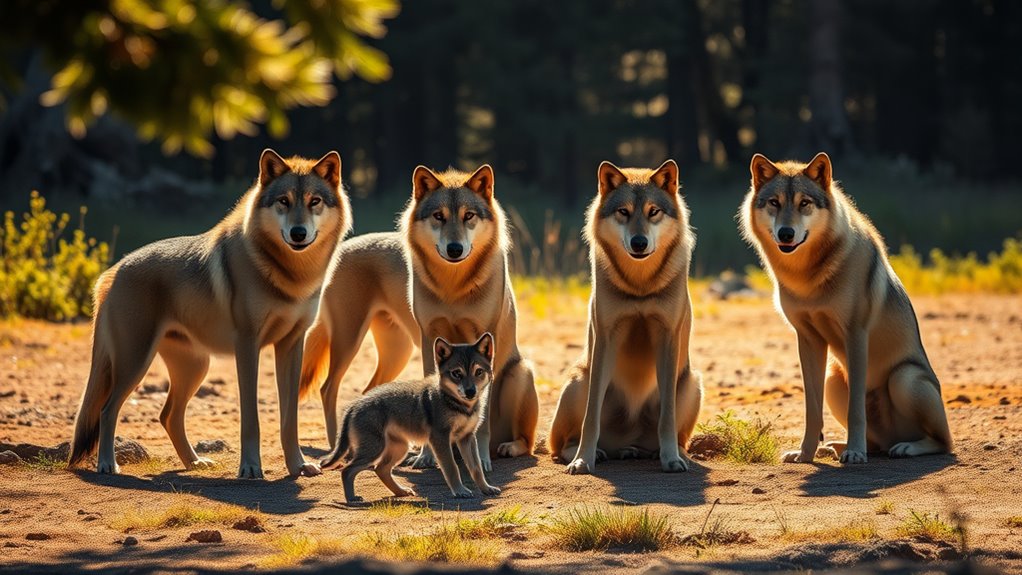Wolf packs have a complex social structure that guarantees their survival. At the top, you've got the alpha pair, who lead through cooperation. Betas serve as second-in-command, while deltas maintain territory and care for others. The omega, or social glue, helps resolve conflicts and nurtures younger wolves. Communication is key, utilizing scents, vocalizations, and body language. Together, these roles foster strong emotional bonds and cultural transmission within the pack. There's so much more to explore!
Key Takeaways
- Wolf packs are led by an alpha pair, who maintain social harmony and organize hunting activities through leadership by example rather than force.
- Betas serve as second-in-command, enforcing discipline, mediating conflicts, and actively participating in hunting to support the pack's food supply.
- Deltas monitor territory, ensuring security, scent marking, and caring for injured members, which fosters resilience and pack cohesion.
- Omega wolves act as the social glue, de-escalating tensions and nurturing younger members, thereby enhancing overall unity within the pack.
- Emotional bonds among pack members promote teamwork and facilitate the transmission of survival skills from older wolves to younger ones.
The Alpha Pair: Leaders of the Pack

While you might think of the alpha pair in a wolf pack as strict leaders, their role is more nuanced than that. They don't dominate through force; instead, they guide the pack with social freedom.
Typically monogamous, they initiate hunts and coordinate activities, ensuring the pack thrives. Alphas enjoy privileges like eating first and accessing resources, reinforcing their status.
Curiously, the death of one alpha doesn't disrupt the other's standing; they quickly find a new mate to maintain stability. Their influence doesn't come from issuing commands but from leading by example, as other wolves naturally follow their lead. This dynamic fosters a cohesive pack, enabling them to navigate challenges together and maintain social harmony, a structure that often includes ritualized fights and posturing to establish rank order among members.
The Role of Betas in Pack Dynamics

The alpha pair may hold the leadership roles in a wolf pack, but the betas are equally important in maintaining the pack's dynamics.
As the second-in-command, betas step up when alphas are absent, enforcing discipline and supporting decision-making. They mediate conflicts, ensuring harmony among pack members, and help maintain stability by making sure everyone follows the alphas' lead.
Betas also contribute to hunting, playing a crucial role in the pack's food supply. With their assertiveness and intelligence, they balance authority and cooperation, earning respect from lower ranks. Beta wolves act as intermediaries to resolve disputes among pack members, showcasing their vital role in the social structure of the pack.
Betas are essential in hunting, blending authority with cooperation to earn the respect of their pack members.
Their adaptability allows them to adjust roles as needed, proving indispensable for the pack's survival and social cohesion. Betas truly are the backbone of the pack's structure.
Mid-Ranking Wolves: Deltas and Their Responsibilities

Mid-ranking wolves, or deltas, play an essential role in territory surveillance, ensuring the pack's domain remains secure. You'll often find them checking for intruders and relaying significant information. Additionally, they take on the important responsibility of caring for ill members, helping to maintain the pack's overall health and cohesion. Their presence is vital as they contribute to the social structure that promotes order and reduces conflicts within the pack.
Territory Surveillance Duties
In wolf packs, deltas play an essential role in territory surveillance, guaranteeing the pack's boundaries remain intact. They actively participate in scent marking along the territory edges, deterring intruders and signaling the pack's presence.
By monitoring both the edges and interior areas, you help detect any potential threats, maintaining the integrity of your pack's domain. Regular patrols are critical, as they allow you to assess changes in the territory and adapt strategies as needed. Most packs have between four and ten members, which means the coordination of surveillance efforts is crucial for effective territory defense.
Communication through howling reinforces territorial claims, while your vigilance guarantees access to important resources. Ultimately, your efforts in territory surveillance contribute notably to the pack's stability and survival, reflecting the strength and unity of the group.
Care for Ill Members**
While managing the complexities of pack life, deltas take on the crucial responsibility of caring for ill or injured members.
These mid-ranking wolves provide critical support, ensuring that sick pack members receive the attention they need to recover. Deltas assist in hunts, bringing food to those who can't hunt for themselves, which promotes social stability. Their role as mid-ranking members helps maintain the pack's safety and well-being.
Their caregiving fosters emotional bonds, strengthening pack cohesion and resilience. This cooperative behavior, often rare in the animal kingdom, helps maintain a robust social structure.
The Omega: Social Glue of the Pack

The omega wolf plays an essential role in resolving conflicts within the pack, acting as a calming presence during tense moments. By accepting their lower status, they strengthen pack cohesion and promote unity among members. Their unique position not only helps maintain harmony but also guarantees the overall stability of the pack. This is particularly important as packs can choose new omegas, allowing for the adaptation and continuity of social structures within the group.
Role in Conflict Resolution
Although omega wolves rank lowest in the pack hierarchy, they play a crucial role in conflict resolution, acting as the social glue that holds the group together.
By using submissive behavior, you'll often see omegas de-escalate tensions between dominant members, channeling aggression away from critical conflicts. Their playful interactions not only relieve stress but also strengthen social bonds, especially with younger wolves. As they engage in these behaviors, they help maintain social bonds and harmony within the pack.
When higher-ranking wolves express minor aggression, omegas absorb it, preventing major disputes from arising. This unique ability to diffuse tension promotes harmony within the pack, allowing it to function effectively.
Fundamentally, omega wolves maintain stability and foster cooperation, making their presence essential for the overall health of the pack dynamics.
Strengthening Pack Cohesion
As omega wolves navigate their lower rank within the pack, they markedly contribute to strengthening pack cohesion. Acting as social glue, they maintain harmony through playful interactions and stress relief. Despite facing aggression from higher-ranking members, their presence is vital for stability. Omega wolves absorb minor aggression, preventing conflicts from escalating and ensuring a balanced social structure. They nurture younger wolves, helping them learn social cues and develop emotional intelligence, all while facilitating social learning through play. By providing a safe outlet for dominance behaviors, they enable pups to practice without risking serious conflict. Ultimately, omega wolves play an invaluable role, fostering cooperation essential for the pack's survival and overall success, as they regulate pack's reproductive activities to prevent overconsumption and ensure survival.
Communication Methods Among Wolves
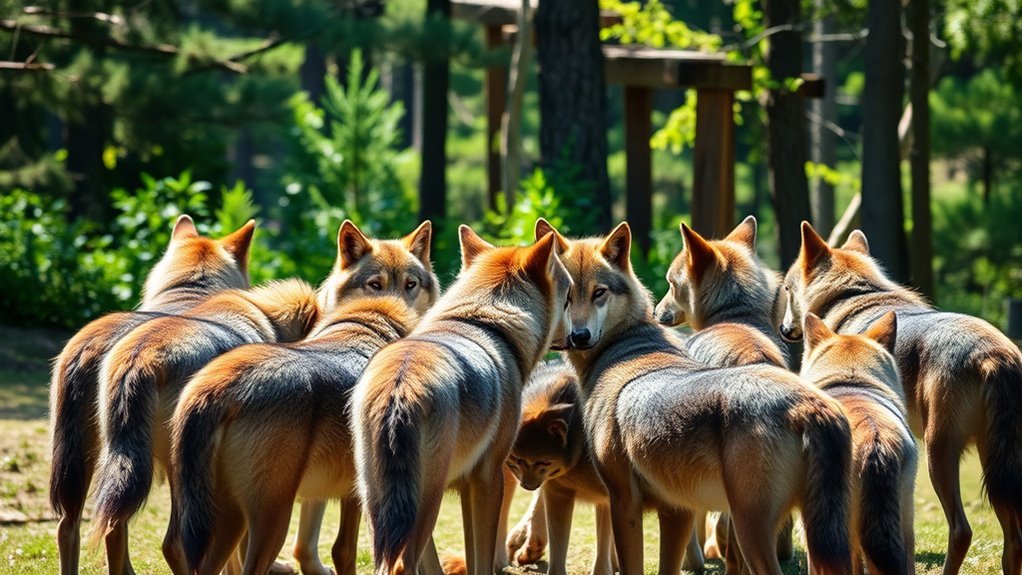
Wolves communicate through a fascinating mix of olfactory, vocal, and visual methods that keep their social structure intact. Each method plays an essential role in maintaining pack cohesion and reducing aggression among members. Scent marking is crucial as it serves to reinforce social hierarchy and clearly delineate territory among the pack.
| Communication Method | Purpose |
|---|---|
| Olfactory | Scent marking for identity and territory |
| Vocal | Howls for long-distance calls and social cues |
| Visual | Body language and facial expressions to convey status |
| Reconciliation | Nose touching and licking to resolve conflicts |
Territorial Behavior and Defense Strategies
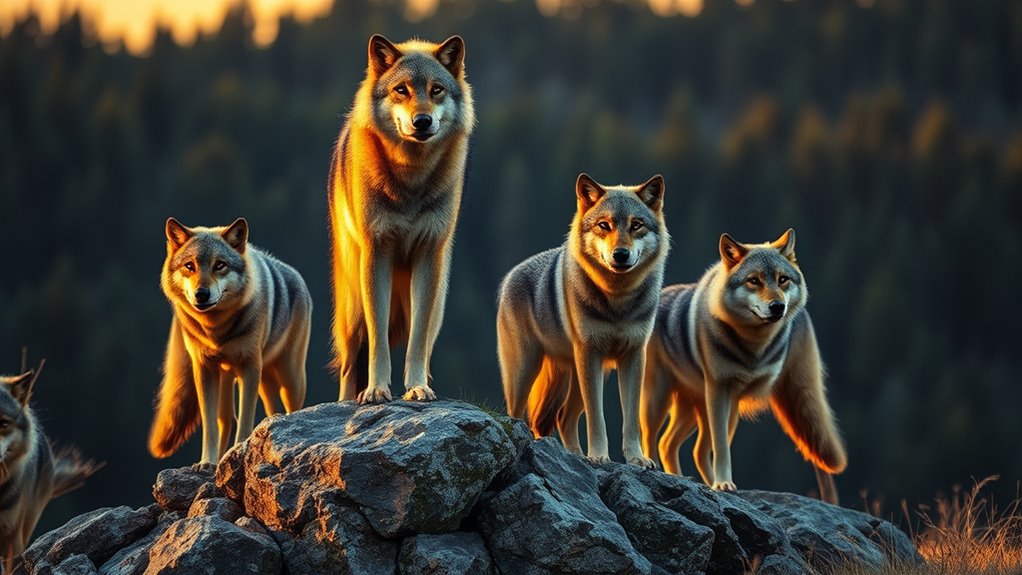
While traversing their complex social structures, wolf packs exhibit fascinating territorial behavior essential for survival. Their territories can range from 33 to 6,200 km², with an average of about 35 km². Territory often overlaps between different wolf packs, which can lead to heightened tensions.
To defend these territories, wolves employ various strategies:
- Scent Marking: They use urine to establish boundaries and deter intruders.
- Vocalizations: Howls and barks signal their presence and warn other packs to stay away.
- Inter-Pack Conflicts: Territorial disputes can lead to battles, with over 60% of wolf deaths resulting from these conflicts.
Survival Strategies and the Importance of Cooperation
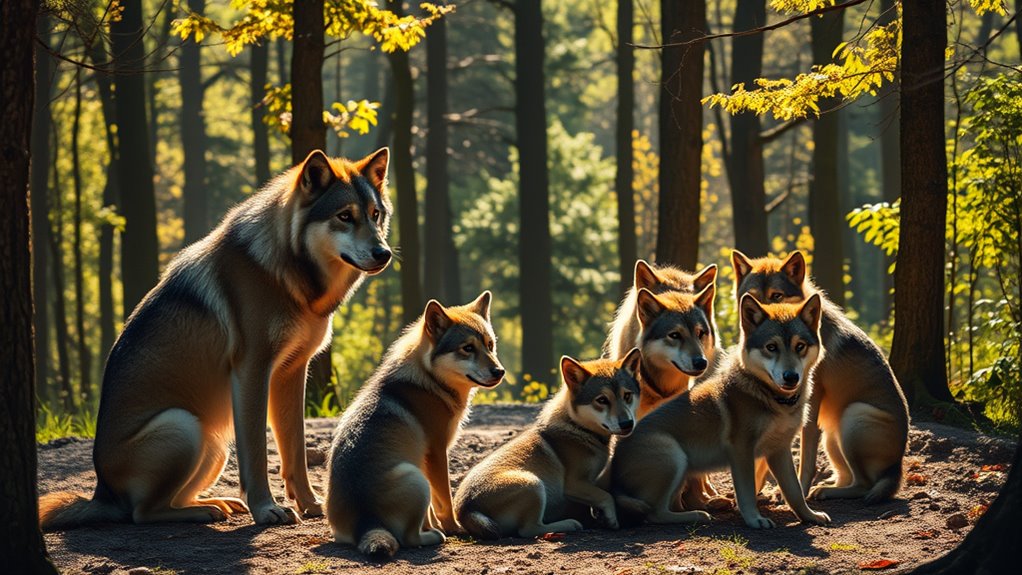
Understanding survival strategies in wolf packs reveals how fundamental cooperation is for their existence. Wolves employ specific hunting techniques, like encircling vulnerable prey while maintaining a safe distance from one another. Each pack member plays a significant role, ensuring successful hunts and minimizing risks. By targeting weak or injured animals, they maximize their chances of securing food. Adaptability is key; wolves adjust their strategies based on prey availability and environmental factors. This cooperation extends beyond hunting; it enhances pack dynamics and reinforces social bonds, allowing for conflict resolution and effective communication. Ultimately, interdependence among pack members is essential, as their survival hinges on working together and supporting one another in their daily challenges. Wolves hunt in packs to take down large prey like moose and bison, demonstrating the effectiveness of their collaborative efforts.
Emotional Bonds and Cultural Transmission in Wolf Packs
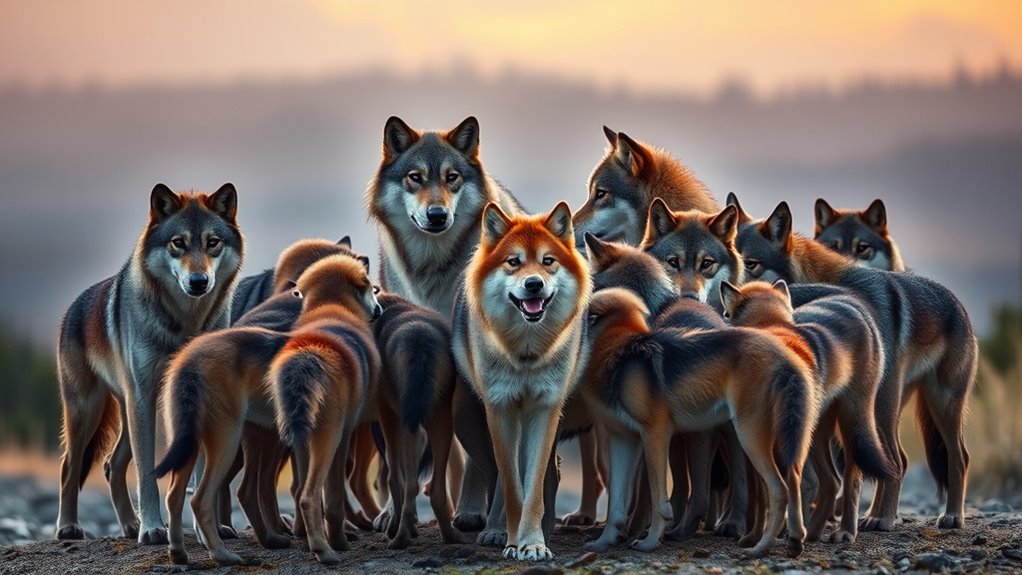
Emotional bonds within wolf packs serve as the foundation for their social structure, fostering cooperation and stability. These connections are essential for various aspects of wolf life:
- Family Ties: Emotional bonds create a cohesive unit, allowing wolves to work together effectively. This is supported by research showing that attachment behaviors in wolves can resemble those seen in dogs.
- Learning and Teaching: Young wolves absorb survival skills from older members, ensuring cultural knowledge is passed down.
- Conflict Reduction: Strong emotional ties minimize disputes, promoting harmony within the pack.
Frequently Asked Questions
How Do Wolves Select Their Pack Leaders?
Wolves select their pack leaders through a combination of dominance hierarchy and experience.
You'll notice that the alpha pair, often the most skilled and assertive, leads the pack.
Younger wolves might challenge them, creating power struggles that can reshape leadership.
When an alpha dies or leaves, the remaining pack members feel the shift, and a new leader emerges, often from the beta pair, ensuring the pack's stability and survival.
What Happens to a Pack After an Alpha Dies?
When the alpha falls, uncertainty grips the pack.
You'll witness a power struggle, as the beta often steps in temporarily, but that won't last.
The dynamics shift; loyalties are tested, and the hierarchy trembles.
Will the eldest pup rise to lead, or will a challenger seize the moment?
Instincts kick in, and survival becomes paramount.
The pack must unite, or chaos could reign, threatening their very existence in the wild.
How Do Wolves Choose Their Mates?
When wolves choose their mates, they primarily rely on their social dynamics and environmental factors.
You'll notice that the alpha pair usually courts, limiting mating among other pack members. Younger wolves often disperse to find partners, ensuring genetic diversity.
Their choices might depend on territory availability, social status, and pack stability.
You'll see that these factors help maintain a healthy population while minimizing inbreeding risks within their ecosystem.
Can Wolves Change Ranks Within Their Pack?
Yes, wolves can change ranks within their pack, but it's a delicate dance.
When a wolf's wisdom or wildness wins out, they might rise higher. Factors like age, ability, and family ties influence these shifts, ensuring stability.
If a leader falls or external pressures mount, opportunities emerge for ambitious wolves.
However, challenges are rare; respect reigns supreme, and conflict resolution is key to maintaining harmony in this tightly knit community.
What Is the Lifespan of a Wolf in the Wild?
Wolves in the wild typically live between 5 to 7 years, although some can reach up to 14 years. Their lifespan is greatly influenced by factors like habitat loss, human intolerance, and prey availability.
In captivity, they can live longer, often up to 16 years, with some exceptional cases reaching over 20 years.
Conclusion
In the intricate dance of wolf pack dynamics, every member plays an essential role, from the commanding alpha pair to the nurturing omega. Together, they weave a tapestry of cooperation and communication that guarantees their survival. By understanding these social structures, you gain insight into the complex relationships that bind them. Just like a well-tuned orchestra, each wolf contributes its unique notes, creating harmony in the wild that echoes through the ages.
